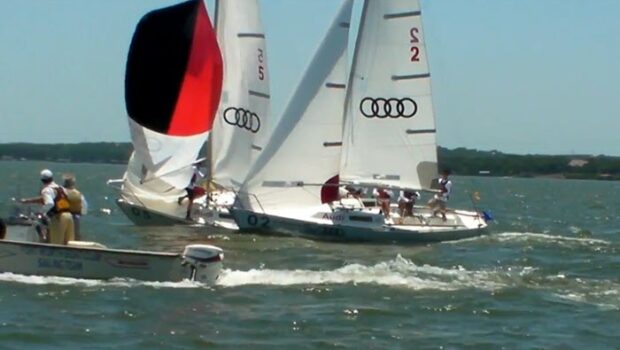Tactics: Last card to play when behind
Published on March 13th, 2023
Noted rules expert Dave Perry promotes match racing, in part because he sees it as a beautiful game, but also as it introduces keelboat racing to youth sailors and magnifies tactical situation that occur in all racing. In The Dial Up newsletter, Perry details one of these situations (and offers recommended music):
There is a desperate boat out on the race course, and you need to beware. It is the boat that you are beating by four lengths or more.
As you near the windward mark for the second time, there is basically only one move left for the trailing boat: to try and intersect you as you leave the windward mark and force you into a foul or bad situation.
It is a desperate move that will not work if the leading boat anticipates it and sets themselves up accordingly. But it is completely within the rules for the trailing boat to try it, and it is usually their last chance to try and win the race.
The move for the trailing boat is to go out to the right and tack on or near the starboard tack layline, and hope the leading boat doesn’t notice them sailing upwind on starboard tack.
The move for the leading boat is to look down the starboard-tack layline *before* rounding the windward mark, and to not sail towards the trailing boat after rounding the mark.
If the lead is large enough, the leading boat may be able to bear away, set their spinnaker, and cross in front of the trailing boat. But that should be tried only if there is NO chance the trailing boat can get a piece of them (which will result in a port/starboard foul or a crash gybe by the leading boat which will likely result in a windward/leeward foul or at least major chaos on the leading boat).
The safest move for the leading boat is to stay high, perhaps even delaying her spinnaker set for a length or so. It is critical that the leading boat be sailing well ABOVE the starboard-tack layline, because the trailing boat has to be sailing no higher than her proper course when she gets near the leading boat (see rule 23.2, Interfering With Another Boat); and up near the windward mark, their proper course is going to be pretty much aiming right at the mark.
The trailing boat can increase their chances of success in these ways. If she is trailing by 4-5 lengths, she can overstand the starboard layline by a length of so. This may give the leading boat the sense that she can bear off and cross in front of the trailing boat.
Because she is overstood, the trailing boat has some wiggle room on where she can aim, as long as she doesn’t aim more than a half a length or so to the left of the mark. The goal of the trailing boat is to get the leading boat to bear away, and then try to position herself so that the leading boat can’t cross her.
If trailing by more than five lengths, then tack about 3-4 lengths below the starboard layline. This encourages the leading boat to do a normal VMG rounding and spinnaker set at the mark.
Because you are under the layline, you have some port tack sailing left on the leg. If you time it just right, you can tack and end up to leeward of the leading boat on port tack.
Some umpires may decide that it was not your proper course to tack before you got to the port tack layline, but some will decide that a boat can choose what tack she wants to sail on to get to the windward mark. The bottom line is: the trailing boat has nothing to lose by trying.
Now, if the trailing boat is able to get under the leading boat, her proper course at that time will be to sail close-hauled and tack, but she won’t be able to tack because the leading boat is overlapped to windward of her. But she can sail up to head to wind, which is her proper course. The leading boat may get a penalty for windward/leeward, or she may end up tacking with her spinnaker up and be in a real mess.
Rule 23.2 (Interfering With Another Boat)
If reasonably possible, a boat shall not interfere with a boat that is taking a penalty, sailing on another leg or subject to rule 21.1. However, after the starting signal this rule does not apply when the boat is sailing her proper course.
Crazy action at the windward mark
What you will see in this video is not one but two consecutive chaotic situations at the windward mark caused by the leading boat not looking down the starboard-tack layline before bearing away and “crossing the street.”









 We’ll keep your information safe.
We’ll keep your information safe.